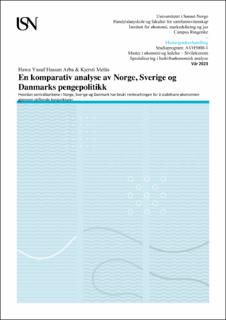| dc.contributor.advisor | Aasnæss, Steinar | |
| dc.contributor.author | Arba, Hawa Yusuf Hassan | |
| dc.contributor.author | Melås, Kjersti | |
| dc.date.accessioned | 2023-07-08T16:41:22Z | |
| dc.date.available | 2023-07-08T16:41:22Z | |
| dc.date.issued | 2023 | |
| dc.identifier | no.usn:wiseflow:6858112:55191902 | |
| dc.identifier.uri | https://hdl.handle.net/11250/3077317 | |
| dc.description.abstract | De pengepolitiske målene for Norge, Sverige og Danmark er noe ulike. Pengepolitikken i Norge og Sverige har som mål å stabilisere aktiviteten og inflasjonen. Pengepolitikken i Danmark har som mål å holde den danske kronen stabil opp mot euroen.
I denne oppgaven har vi sett på hvordan sentralbankene i Norge, Sverige og Danmark har brukt rentesettingen til å stabilisere økonomien gjennom skiftende konjunkturer. Vi har derfor sett på hvordan sentralbanken har reagert med å sette renten i forhold til endringer i BNP- gapet, inflasjonsgapet og valutakursene. For å avdekke likheter og ulikheter har vi vurdert disse dataene grafisk ved å sammenligne trendfigurer for flere variabler mellom de tre landene. I tillegg har vi fremstilt variablene grafisk for hvert land for å se på utviklingen og sentralbankens handlingsmønster separat.
Resultatene har vist at alle tre landene har reagert likt under kraftige negative sjokk i økonomien. Vi kan også se at konjunkturene i de respektive landene har utviklet seg nokså likt. Vi har også bemerket oss at sentralbanken i Norge har et dilemma ved rentesetting ut ifra et aktivitetsmål og et inflasjonsmål dette er fordi de har en tendens til å fluktuere i motsatte retninger. I Sverige og Danmark kan vi se at aktivitetsmålet og inflasjonsmålet følger i samme trend.
Vi har også undersøkt hvordan de ulike sentralbankene har vektlagt de ulike målene for sin rentesetting gjennom en korrelasjonsanalyse. Etter vi hadde foretatt en korrelasjonsanalyse, ser vi at funnene i denne avhandlingen ikke gir oss ett tilstrekkelig grunnlag for å støtte opp under de pengepolitiske målene som skal vektlegges i størst grad under deres rentesetting. | |
| dc.description.abstract | The objectives of the monetary policy in Norway, Sweden, and Denmark have some differences. The objectives of monetary policy in Norway and Sweden are to control the inflation and activity towards the target. The goal of the Danish monetary policy is to maintain the Danish krone's parity to the euro.
In this thesis, we have examined how the central banks in Norway, Sweden and Denmark have used the interest rate to stabilize the economy through cyclical fluctuations. As a result, we have examined how the central bank has responded by establishing interest rates in relation to changes in the GDP-gap, inflation-gap, and the exchange rates. In order to uncover similarities and differences, we have graphically evaluated this data by comparing trend figures for several variables between these three countries. Additionally, we combined these variables for each country in a graphic representation.
The key conclusions that emerged from reviewing the graphs were that all central banks responded uniformly to significant negative shocks to the economy. We can also see that there is a similarity between the cyclical fluctuations in the three countries. We have also observed a possible dilemma for the Norwegian central bank in terms of interest rate setting, because the activity and the inflation target tend to fluctuate in the opposite direction. Through a correlation analysis, we have also looked at how the central banks have emphasized the various goals for setting interest rates. After conducting a correlation analysis, we can observe that the conclusions of this thesis do not provide us with a solid enough foundation to support the monetary policy objectives of what should be emphasized the most. | |
| dc.language | nob | |
| dc.publisher | University of South-Eastern Norway | |
| dc.title | En komparativ analyse av Norge, Sverige og Danmarks pengepolitikk | |
| dc.type | Master thesis | |
